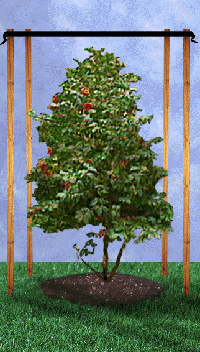Burke’s Backyard visited a garden where three years previously 87 healthy camellias had been moved and are now sick and dying because the plants never established a new root system. Burke’s Backyard consulted with camellia experts Dr Brett Summerell, plant pathologist at the Royal Botanic Gardens in Sydney and Clint Bawden, landscaper to advise on moving or transplanting a camellia the correct way.
Revitalising a sick camellia
Attempting to revitalise a sick plant is difficult but is possible.
Fork the soil around the plant and if a heavy clay soil, add gypsum to assist in breaking up the clay.
Water in some Seasol (500mL costs $10.90) around the root zone to promote root growth and allow the water to penetrate through the soil.
Add a light mulch to encourage earth worms and other activity around the roots.
As a safeguard against the possibility of root rot spray the foliage with Phosacid 200 (5L costs $30) which is a safe chemical to use and will keep the root rot at bay.
Spray an antitranspirant such as Stressguard (200mL costs $10.50) on the foliage to minimise moisture loss.
Moving a camellia
Camellias are amongst the most beautiful and versatile flowering shrubs for the garden and transplanting one does not have to mean losing the plant altogether.
The best time to move a plant is in the cooler months of the year in June, July or August so that you’re moving it when it’s dormant.
Dig a trench around the plant and dig up as much of the roots as possible. Be gentle with the roots and try not to break them up too much.
Most gardeners and gardening books would advise you to compensate for the pruned roots by pruning something off the top of the plant. However, our research has shown that it is detrimental to touch the top of the plant. Leave it intact and replant or pot the plant in good potting mix and the plant will re-establish itself.
Note: If replanting in the garden, plant in a raised garden bed to avoid any problems with clay soil. Alternatively add gypsum to the soil to break up the clay.
Spray the plant with Phosacid 200 to stop root rot. Phosacid 200 is an environmentally safe chemical to use in the garden.
Use an antitranspirant such as Stressguard or Envy (1L costs $16.95) to stop the plant losing moisture through the leaves and protect it from frost.
Water the plant well and keep shaded for four to six weeks. If it is planted in the ground erect some stakes and drape shade cloth with a 70% rating over the plant to protect it from the sun (see diagram).
Don Burke advises to avoid pruning a camellia and certainly never prune it severely. If you want to prune a camellia, wait until it is well established and prune it in stages.



